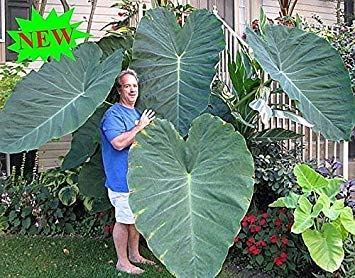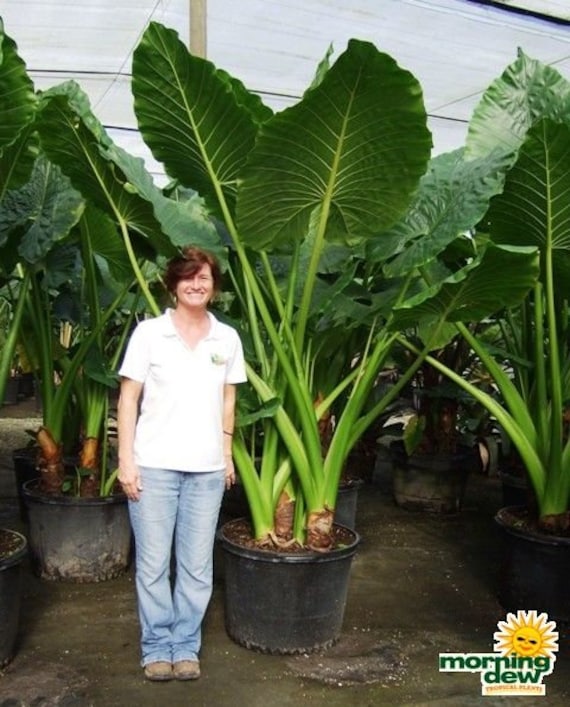If you’ve been looking for elephant ear plant broken stem, I can tell you that cultivating this plant has its challenges, such as yellowing, browning, and broken stems. So here is the answer to this specific problem and how it will be fixed.
To remedy the elephant ear plant damaged stem Either cut the damaged stem off and remove it from the base, or wait a few months and the elephant ear plant will regrow a new stem. In order to fix this, you can also use a stick or pencil tied to the stem with thread or string. This will need to sustain it while the main plant fixes the problem. If the stem is broken, this will still function. I believe tapping to be the simplest approach, however you must give the stick some ground support, and the knotted stem will work just well when tapped with the stick. You can also use a pencil if you don’t have a stick to do it.
Straight sticks will still function if the stem breaks. However, if it is totally damaged, cut it off at the base and remove it. It will regrow.
If you’ve grown it outside, it can be easily harmed by strong winds, however some people choose to place it close to wooden fences to shield them from wind damage. A common problem is improper handling, and if you have a pet, it might leap over it and break one or two stems. It simply requires attention to detail and careful management of everything.
Table of Contents
What to Do When your Elephant Ear Plant Has a Broken Stem?
When you have given an elephant ear plant a lot of attention and care, discovering a damaged stem can be disappointing. When something genuinely occurs to their elephant ears, many people hear this for the first time.
Check the stem first to see if it is partially fractured and repairable or entirely detached from the main stem. The steps are listed below, and you should adhere to them for both reasons:
Partial Broken Stem on Elephant Ear Plant
Therefore, if a stem from your elephant plant is partially broken but still connected to the main stem, you should be glad that there is still a chance the plant will recover.
The suggested actions to fix the broken stem on your elephant ear plant are listed below.
Even after treating the broken stem in every way, it may occasionally fail to mend, become brown, and begin to wither from the inside out. Because of this, I assert that there is no assurance that it will succeed. But if we take the necessary action, who knows if the fractured stem will survive and regrow.
Good fortune.
Complete Broken Stem on Elephant Ear Plant
Second, if your elephant plant has a broken stem that is entirely disconnected from the main stem, it has no chance of surviving and you should remove it right once.
Now that the damaged stem is separated from the plant, you have options.
The plant benefits when we chop off the existing portion because it won’t have to divide the nutrients for the other stems. The elephant plant will now concentrate on the plant’s most recent and current growth, and after a month or two you should start to notice fresh growth.
Why is my elephant ear plant bending? (Causes)
Elephant ear plant soft stem
Your elephant ear plant’s stem may occasionally grow mushy from overwatering or poor lighting, which makes it droop. Due to the weight of the enormous leaves, this fragile stem issue makes the plant stem bend and break easily.
Elephant plant leaves tend to be bulky, and if your plant’s stem is soft, this could result in a partially or entirely broken stem.
How to Fix
By giving the elephant plant the right amount of light and avoiding overwatering, you may prevent the soft stem from spreading out in search of illumination. Establish a regular watering routine to ensure that your plant doesn’t feel thirsty and that you don’t overwater it for a few days.
Stem rot
A fungus called elephant ear plant stem rot attacks the plant. The Phytophthora family of fungi causes it, which can cause the plant’s stems to become brittle and break. The fungus thrives in areas with poor drainage and humid climates, spreading through the soil. Stem rot symptoms include brown spots or stains on the stems, discolored leaves, wilting, and yellowing of the foliage.
How to Fix
By keeping the plant in well-draining soil and avoiding overwatering, elephant ear plant stem rot can be avoided. The risk of a fungus infection can also be reduced by avoiding wetting the plant’s foliage.
Poor and Improper Light
Elephant ears with weak stems may be the result of insufficient or poor lighting. The lack of nutrients and energy from light that the plant senses is what causes this. Weak stems are the result of insufficient energy from the sun being received by the plant. Weak stems can be highly demoralizing for a gardener because they are more likely to break.
How to Fix
Make sure the plant receives adequate light, water, and nutrients to avoid elephant ears with broken stems. By adhering to these guidelines, one can avoid elephant ears with weak and broken stems.
Natural strong winds
Strong winds are frequently to blame for a significant portion of the broken stems in elephant ear plants. A strong enough wind might tear the plant’s stalks away from the base, leaving them vulnerable to fracture. The elephant ear plant can wobble and bow as a result of its large leaves catching the wind, shattering stems in the process. Strong winds may even cause the plant to collapse over, breaking stems and perhaps harming roots in the process.
How to Fix
To avoid developing broken stems, make sure the elephant ear plant is firmly planted in the ground and protected from severe winds.
Elephant ear plant has Lack of Nutrients
Elephant ear plant stems may snap due to nutritional deficiency. The plant becomes weakened and may even break when macronutrients like nitrogen, phosphate, and potassium are out of balance. Deficits in iron, zinc, and magnesium can harm stems as well. The stem of an elephant ear plant will grow brittle without adequate nutrients.
How to Fix
For the elephant ear plant to receive the proper nutrients, frequent fertilizer and watering are necessary. Elephant ear plant care done correctly discourages stem breaking and encourages growth.
Cold Temperature
Elephant ear plants have trouble growing in the cold and their stems break at temperatures below 55°F. due to the stems’ inability to withstand cold conditions. If the stems are left outside in cold weather, they can snap. In abrasive circumstances, plants can perish.
How to Fix
Elephant ear plants are hardy and will grow again as the weather becomes warmer. To prevent broken stems, bring the plant indoors or protect it from the cold.
How do you fix a bent elephant ear stem?
Elephant ear stems should be tied with something like a wooden stick as soon as they get somewhat bowed or start to slope downhill.
Let me explain the procedure in detail so you can fully comprehend it:
Can I Use Elephant ear plant broken stem for Propagation?
How much time does it take for a broken stem to heal?
If they are entirely separated, there is very little chance of saving a damaged stem. However, there is still hope because it takes 5–6 weeks for the stem to generate new leaves after the severed half is reattached, and until then the leaf may become brown.
Elephant ear plant Shoot broken
Elephant ear plant root rot typically occurs when the plant has a fungal infection and receives excessive watering. These plants often grow in moist soil, not wet, so take good care of it. Elephant ear plants also experience a variety of issues, such as leaf yellowing, browning, nutrient insufficiency, and other issues that weaken the plant’s general health.
Purchase an elephant ear plant on Etsy (recommended)
Amazon sells elephant ear plants.
Fix Fungal and Other Leaf Diseases – Elephant Ear Leaf Problems.
Info Elephant Ear plant
Colocasia, sometimes known as the elephant plant, is an indoor evergreen with enormous leaves that is typically grown outdoors. It is a tropical plant that is simple to grow and maintain. Warmer climates allow for year-round growth; even during winters, they have little effect and allow for springtime regrowth with minimal mineral supplementation. It need a big container and a location to put it if you truly want to grow them indoors. It has very enormous, naturally heart-shaped leaves that give it a very distinctive appearance. The reason why most people cultivate them is for their striking texture, which is utilized to highlight and create a garden full of lush green leaves.
Pruning Colocasia?



